Cumulative Dietary Risk Assessment of Benzophenone-Type Photoinitiators from Packaged Foodstuffs
Abstract
:1. Introduction
2. Materials and Methods
2.1. Chemicals and Reagents
2.2. Food Sampling
2.3. Sample Pretreatment
2.4. Instrumental Analysis
2.5. Validation Procedure
2.6. ME and Process Efficiency
2.7. Hazard Characterization and Health-Based Guidance Values
2.8. Exposure Assessment
2.8.1. Exposure Scenario
2.8.2. Exposure Assessment
2.9. Risk Characterization
3. Results
3.1. Method Validation
3.2. BP Levels in Breakfast Cereals with Different Packaging Materials
3.3. BP Levels in F&V Juices and Milk with Different Packaging Materials
3.4. ADD of BPs for Different Age Groups
3.5. Sensitivity Analysis for the Age Group of 19–65 Years
3.6. Dietary Risk Characterization
4. Discussion
4.1. BP Levels in Different Foods and Types of Packaging Materials
4.2. Dietary Risk Characterization
4.3. Comparison of Different Risk Assessment Approaches
4.4. Strengths and Limitations
5. Conclusions
Supplementary Materials
Author Contributions
Funding
Institutional Review Board Statement
Informed Consent Statement
Data Availability Statement
Acknowledgments
Conflicts of Interest
Abbreviations
References
- National Toxicology Program. Toxicology and carcinogenesis studies of Benzophenone (CAS No. 119-61-9) in F344/N rats and B6C3F1 mice (Feed Studies). Natl. Toxicol. Program Technol. Rep. Ser. 2006, 533, 1–264. [Google Scholar]
- HSDB (Hazardous Substances Data Bank). Benzophenone. Hazardous Substance Database. 2010. Available online: https://pubchem.ncbi.nlm.nih.gov/source/hsdb/6809 (accessed on 1 July 2020).
- Koivikko, R.; Pastorelli, S.; Rodríguez-Bernaldo de Quirós, A.; Paseiro-Cerrato, R.; Paseiro-Losada, P.; Simoneau, C. Rapid multi-analyte quantification of benzophenone, 4-methylbenzophenone and related derivatives from paperboard food packaging. Food Addit. Contam. 2010, 27, 1478–1486. [Google Scholar] [CrossRef] [PubMed]
- Nerín, C.; Asensio, E. Migration of organic compounds from a multilayer plastic–paper material intended for food packaging. Anal. Bioanal. Chem. 2007, 389, 589–596. [Google Scholar] [CrossRef]
- Pastorelli, S.; Sanches-Silva, A.; Cruz, J.M.; Simoneau, C.; Losada, P.P. Study of the migration of benzophenone from printed paperboard packages to cakes through different plastic films. Eur. Food Res. Technol. 2008, 227, 1585–1590. [Google Scholar] [CrossRef]
- Skjevrak, I.; Brede, C.; Steffensen, I.-L.; Mikalsen, A.; Alexander, J.; Fjeldal, P.; Herikstad, H. Non-targeted multi-component analytical surveillance of plastic food contact materials: Identification of substances not included in EU positive lists and their risk assessment. Food Addit. Contam. 2005, 22, 1012–1022. [Google Scholar] [CrossRef] [PubMed]
- European Commission–Health and Consumers Directorate General. Standing Committee on the Food Chain and Animal Health Section Toxicological Safety Conclusions of the Meeting of 6 March 2009, Bruxelles, Belgium, 6 March 2009. Available online: https://www.foedevarestyrelsen.dk/SiteCollectionDocuments/25_PDF_word_filer%20til%20download/05kontor/SCOFCAH-dok%20om%204MB-trykfarve-2009.pdf (accessed on 1 July 2020).
- CS AFSCA Belgium. Comité Scientifique de l’AgenceFédérale pour la Sécurité de la Chaine Alimentaire.Migration de 4-méthylbenzophénone de l’emballageen carton imprimé vers les céréales de petit déjeuner(dossier 2009/05); Autorité européenne de sécurité des aliments (EFSA): Gembloux, Belgium, 2009. [Google Scholar]
- European Commission. Commission Directive 2002/72/EC of 6 August 2002 Relating to plastic materials and articles intended to come into contact with foodstuffs. Off. J. Eur. Union 2002, 220, 18–58. [Google Scholar]
- Swiss Confederation. Verordnung des EDI über Materialien und Gegenstände, die dazu Bestimmt Sind, mit Lebensmitteln in Berührung zu Kommen (SR 817.023.21). 2017. Available online: https://www.fedlex.admin.ch/eli/cc/2017/164/de/ (accessed on 1 July 2020).
- European Commission. Commission Regulation (EU) No 10/2011 of 14 January 2011 on plastic materials and articles intended to come into contact with food. Off. J. Eur. Union 2011, 12, 1–89. [Google Scholar]
- Germany Federal Ministry of Food and Agriculture. Twenty-First Ordinance: Amending the Consumer Goods Ordinance. 2017. Available online: https://www.bmel.de/SharedDocs/Downloads/EN/_Consumer-Protection/DruckfarbenVO-EN.html (accessed on 3 March 2020).
- Embry, M.R.; Bachman, A.N.; Bell, D.R.; Boobis, A.R.; Cohen, S.M.; Dellarco, M.; Dewhurst, I.C.; Doerrer, N.G.; Hines, R.N.; Moretto, A.; et al. Risk assessment in the 21st century: Roadmap and matrix. Crit. Rev. Toxicol. 2014, 44, 6–16. [Google Scholar] [CrossRef]
- Pastoor, T.P.; Bachman, A.N.; Bell, D.R.; Cohen, S.M.; Dellarco, M.; Dewhurst, I.C.; Doe, J.E.; Doerrer, N.G.; Embry, M.R.; Hines, R.N.; et al. A 21st century roadmap for human health risk assessment. Crit. Rev. Toxicol. 2014, 44, 1–5. [Google Scholar] [CrossRef] [Green Version]
- EFSA Scientific Committee. Guidance on the use of the Threshold of Toxicological Concern approach in food safety assessment. EFSA J. 2019, 17, e05708. [Google Scholar]
- U.S. Food and Drug Administration. FR 36582-Food additives: Threshold of regulation for substances used in food contact articles. Fed. Regist. 1995, 60, 36582–36596. [Google Scholar]
- EFSA Panel on Food Contact Materials, Enzymes, Flavourings and Processing Aids (CEF). Recent developments in the risk assessment of chemicals in food and their potential impact on the safety assessment of substances used in food contact materials. EFSA J. 2016, 14, 4357. [Google Scholar]
- Chuang, W.-C.; Chen, J.-W.; Huang, C.-H.; Shyu, T.-H.; Lin, S.-K. FaPEx® Multipesticide Residues Extraction Kit for Minimizing Sample Preparation Time in Agricultural Produce. J. AOAC Int. 2019, 102, 1864–1876. [Google Scholar] [CrossRef]
- Lo, Y.L.; Hsieh, Y.T.; Hsu, L.L.; Chuang, S.Y.; Chang, H.Y.; Hsu, C.C.; Chen, C.Y.; Pan, W.H. Dietary pattern associated with frailty: Results from nutrition and health survey in Taiwan. J. Am. Geriatr. 2017, 65, 2009–2015. [Google Scholar] [CrossRef]
- Huang, Y.-F.; Chien, J.-T.; Chen, H.-C.; Liu, X.-R.; Chang, J.-P.; Huang, J.-J. Rapid determination of benzophenone derivatives in cereals using FaPEx coupled with ultra-high-performance liquid chromatography-tandem mass spectrometry. J. Food Drug. Anal. 2021, 29, 287–302. [Google Scholar] [CrossRef]
- Codex Alimentarius. Guidelines on Performance Criteria for Methods of Analysis for the Determination of Pesticide Residues in Food and Feed; CXG90; CAC: Rome, Italy, 2017. [Google Scholar]
- Administration TFDA. Validation Guide of Food Chemical Testing Methods; Taiwan Food and Drug Administration: Taipei, Taiwan, 2013.
- de Oliveira Arias, J.L.; Rombaldi, C.; Caldas, S.S.; Primel, E.G. Alternative sorbents for the dispersive solid-phase extraction step in quick, easy, cheap, effective, rugged and safe method for extraction of pesticides from rice paddy soils with determination by liquid chromatography tandem mass spectrometry. J. Chromatogr. A 2014, 1360, 66–75. [Google Scholar] [CrossRef]
- EFSA. Scientific Opinion of EFSA prepared by the Panel on food contact materials, enzymes, flavourings and processing aids (CEF) on Toxicological evaluation of benzophenone. EFSA J. 2009, 1104, 1–30. [Google Scholar]
- Toxtree v3.1.0. Available online: http://toxtree.sourceforge.net/cramer.html (accessed on 20 June 2019).
- de Quirós, A.R.B.; Cardama, A.L.; Sendón, R.; Ibarra, V.G. Food Contamination by Packaging: Migration of Chemicals from Food Contact Materials; Walter de Gruyter GmbH & Co. KG: Santiago de Compostela, Spain, 2019. [Google Scholar]
- Minnesota Department of Health. Toxicological Summary for Benzophenone. Available online: https://www.health.state.mn.us/communities/environment/risk/docs/guidance/gw/benzophenone.pdf (accessed on 10 July 2021).
- Health Canada. Screening Assessment Methanone, diphenyl-(Benzophenone). Available online: https://www.canada.ca/content/dam/eccc/documents/pdf/pded/benzophenone/Screening-assessment-benzophenone.pdf (accessed on 1 July 2021).
- ECHA (European Chemicals Agency). 4-Hydroxybenzophenone Toxicological Information. 2019. Available online: https://echa.europa.eu/mt/registration-dossier/-/registered-dossier/18159/7/6/1 (accessed on 1 July 2020).
- ECHA (European Chemicals Agency). 4-Phenylbenzophenone Toxicological Information. 2018. Available online: https://echa.europa.eu/mt/registration-dossier/-/registered-dossier/25482/7/6/1 (accessed on 1 July 2020).
- ECHA (European Chemicals Agency). Methyl 2-Benzoylbenzoate Toxicological Information. 2015. Available online: https://echa.europa.eu/mt/registration-dossier/-/registered-dossier/16686/7/6/1 (accessed on 1 July 2020).
- EFSA. Management of left-censored data in dietary exposure assessment of chemical substances. EFSA J. 2010, 8, 1557. [Google Scholar]
- Chang, W.-H.; Chen, H.-L.; Lee, C.-C. Dietary exposure assessment to perchlorate in the Taiwanese population: A risk assessment based on the probabilistic approach. Environ. Pollut. 2020, 267, 115486. [Google Scholar] [CrossRef] [PubMed]
- Wilkinson, C.F.; Christoph, G.R.; Julien, E.; Kelley, J.M.; Kronenberg, J.; McCarthy, J.; Reiss, R. Assessing the risks of exposures to multiple chemicals with a common mechanism of toxicity: How to cumulate? Regul. Toxicol. Pharmacol. 2000, 31, 30–43. [Google Scholar] [CrossRef]
- Benzophenone and 4-Hydroxybenzophenone Migration from Food Packaging Into Foods. Food Survey Information Sheet. 2006. Available online: http://www.food.gov.uk/science/surveillance/fsisbranch2006/fsis1806 (accessed on 1 July 2020).
- Shen, D.-X.; Lian, H.-Z.; Ding, T.; Xu, J.-Z.; Shen, C.-Y. Determination of low-level ink photoinitiator residues in packaged milk by solid-phase extraction and LC-ESI/MS/MS using triple-quadrupole mass analyzer. Anal. Bioanal. Chem. 2009, 395, 2359–2370. [Google Scholar] [CrossRef]
- Rodriguez-Bernaldo de Quiros, A.; Paseiro-Cerrato, R.; Pastorelli, S.; Koivikko, R.; Simoneau, C.; Paseiro-Losada, P. Migration of photoinitiators by gas phase into dry foods. J. Agric. Food Chem. 2009, 57, 10211–10215. [Google Scholar] [CrossRef]
- Anderson, W.; Castle, L. Benzophenone in cartonboard packaging materials and the factors that influence its migration into food. Food Addit. Contam. 2003, 20, 607–618. [Google Scholar] [CrossRef]
- Baner, A.; Bieber, W.; Figge, K.; Franz, R.; Piringer, O. Alternative fatty food simulants for migration testing of polymeric food contact materials. Food Addit. Contam. 1992, 9, 137–148. [Google Scholar] [CrossRef] [PubMed]
- Vaclavikova, M.; Paseiro-Cerrato, R.; Vaclavik, L.; Noonan, G.O.; DeVries, J.; Begley, T.H. Target and non-target analysis of migrants from PVC-coated cans using UHPLC-Q-Orbitrap MS: Evaluation of long-term migration testing. Food Addit. Contam. Part A 2016, 33, 352–363. [Google Scholar] [CrossRef]
- Sanches-Silva, A.; Pastorelli, S.; Cruz, J.; Simoneau, C.; Paseiro-Losada, P. Development of a multimethod for the determination of photoinitiators in beverage packaging. J. Food Sci. 2008, 73, C92–C99. [Google Scholar] [CrossRef]
- Gallart-Ayala, H.; Núñez, O.; Moyano, E.; Galceran, M.T. Analysis of UV ink photoinitiators in packaged food by fast liquid chromatography at sub-ambient temperature coupled to tandem mass spectrometry. J. Chromatogr. A 2011, 1218, 459–466. [Google Scholar] [CrossRef] [PubMed] [Green Version]
- Ozaki, A.; Kawasaki, C.; Kawamura, Y.; Tanamoto, K. Migration of bisphenol A and benzophenones from paper and paperboard products used in contact with food. Shokuhin Eiseigaku Zasshi J. Food Hyg. Soc. Jpn. 2006, 47, 99–104. [Google Scholar] [CrossRef] [Green Version]
- Johns, S.M.; Jickells, S.M.; Read, W.A.; Castle, L. Studies on functional barriers to migration. 3. Migration of benzophenone and model ink components from cartonboard to food during frozen storage and microwave heating. Packag. Technol. Sci. 2000, 13, 99–104. [Google Scholar] [CrossRef]
- Choi, J.O.; Jitsunari, F.; Asakawa, F.; Park, H.J.; Lee, D.S. Migration of surrogate contaminants in paper and paperboard into water through polyethylene coating layer. Food Addit. Contam. 2002, 19, 1200–1206. [Google Scholar] [CrossRef] [PubMed]
- Castle, L. Migration from recycled paper and board to dry foods. Research into the factors involved, leading to practical avoidance and amelioration measures. World Food Regul. Rev. 2004, 13, 11–12. [Google Scholar]
- Davis, J.A.; Gift, J.S.; Zhao, Q.J. Introduction to benchmark dose methods and U.S. EPA’s benchmark dose software (BMDS) version 2.1.1. Toxicol. Appl. Pharmacol. 2011, 254, 181–191. [Google Scholar] [CrossRef] [PubMed]
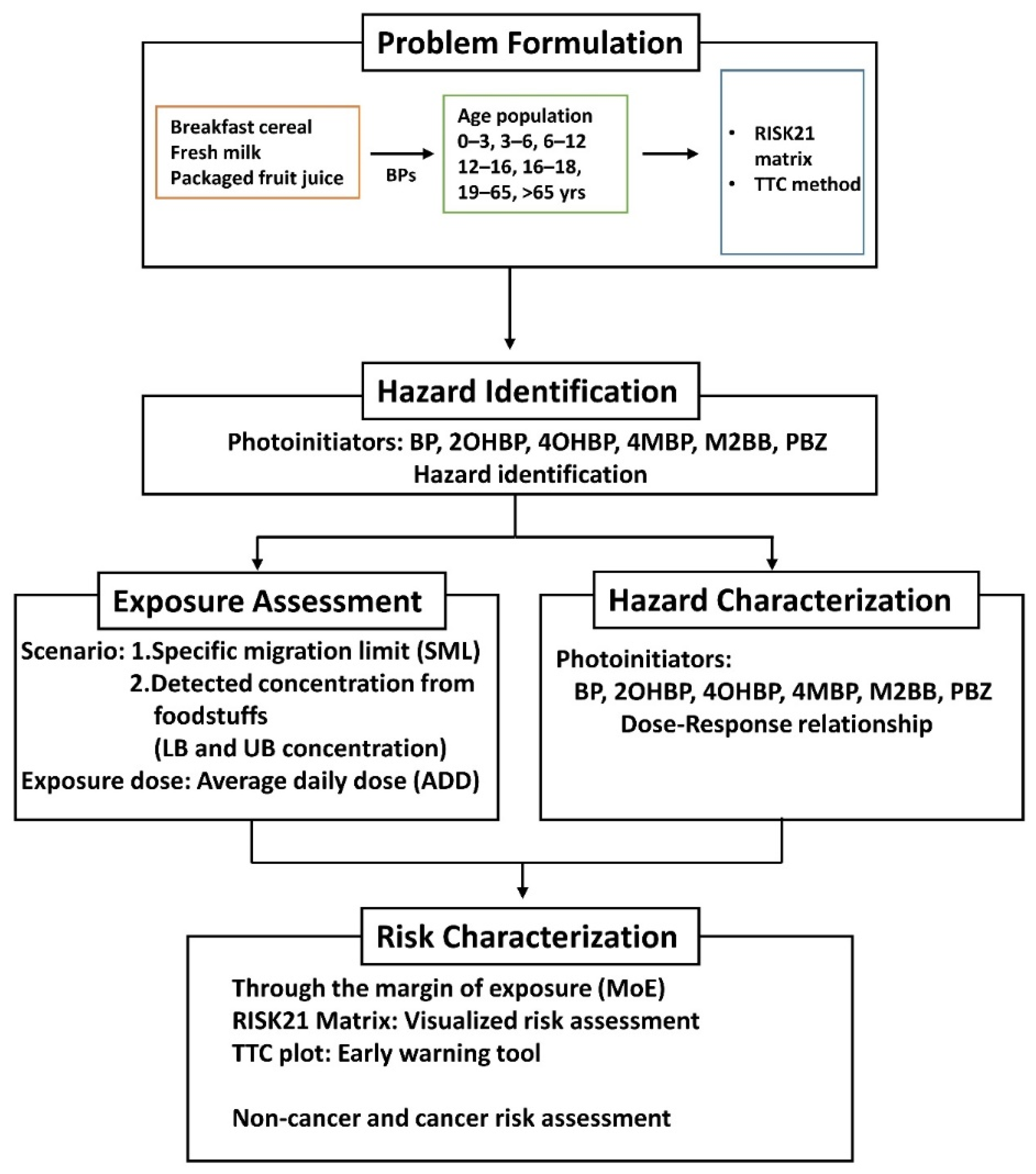
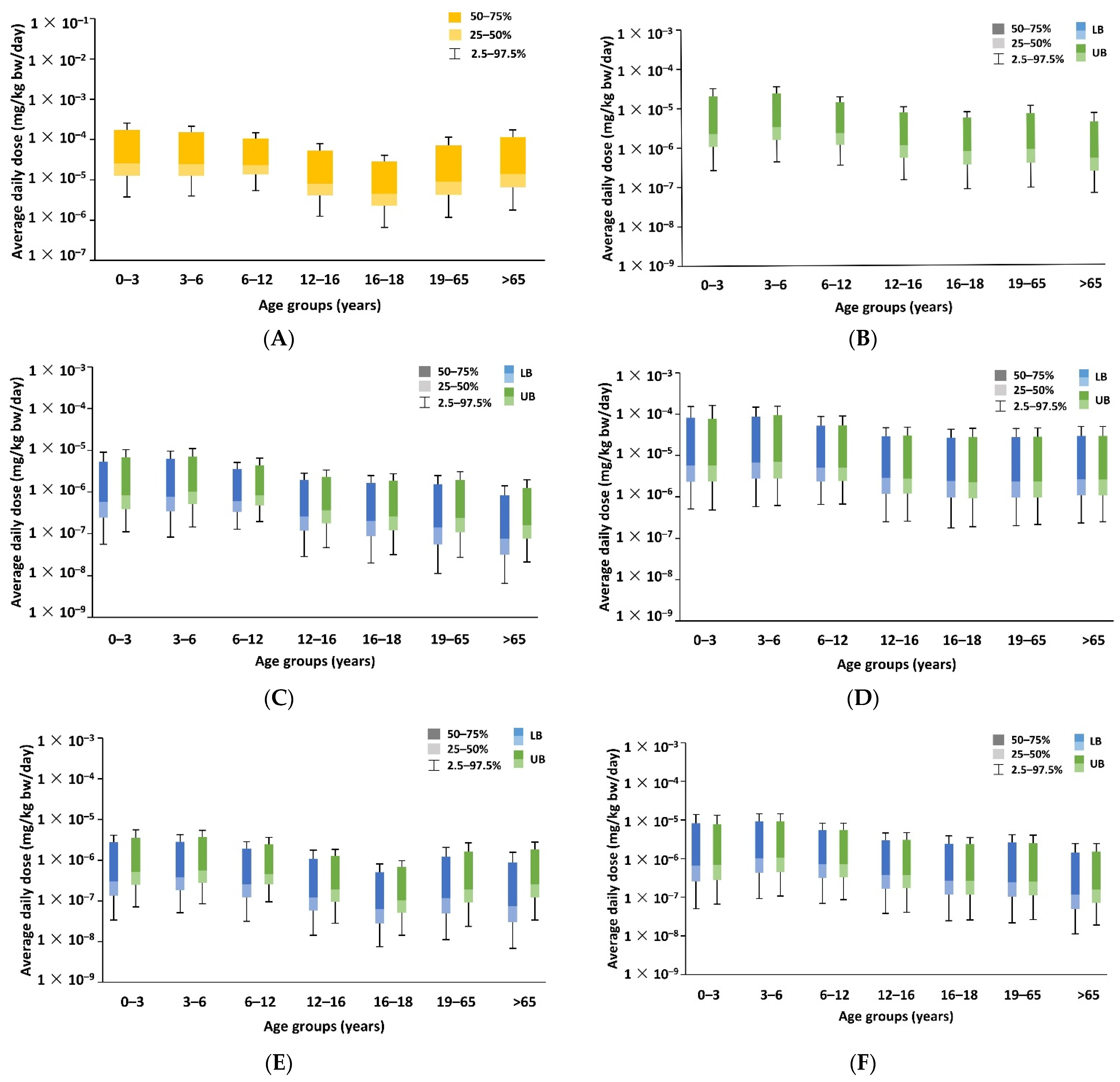
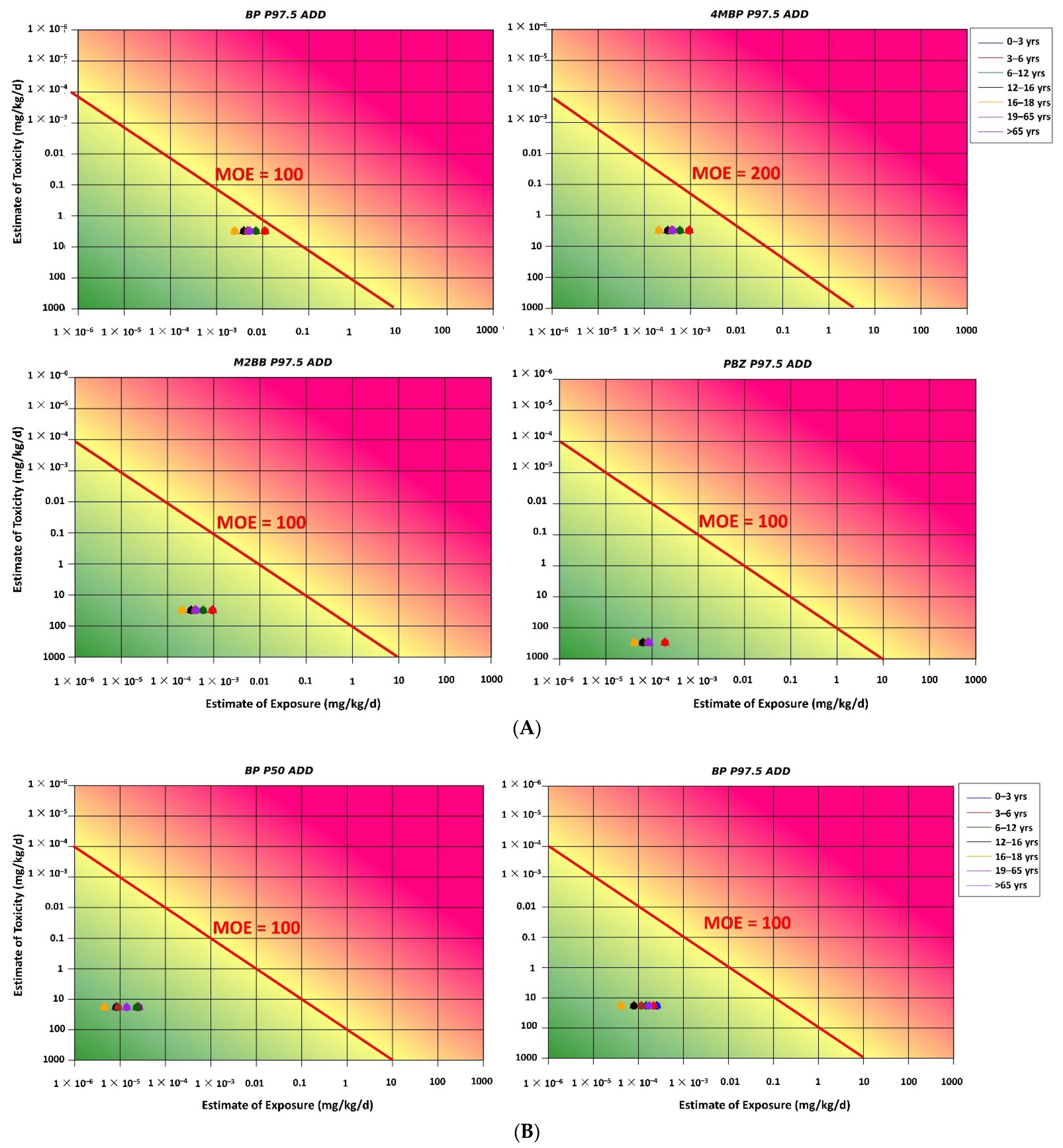

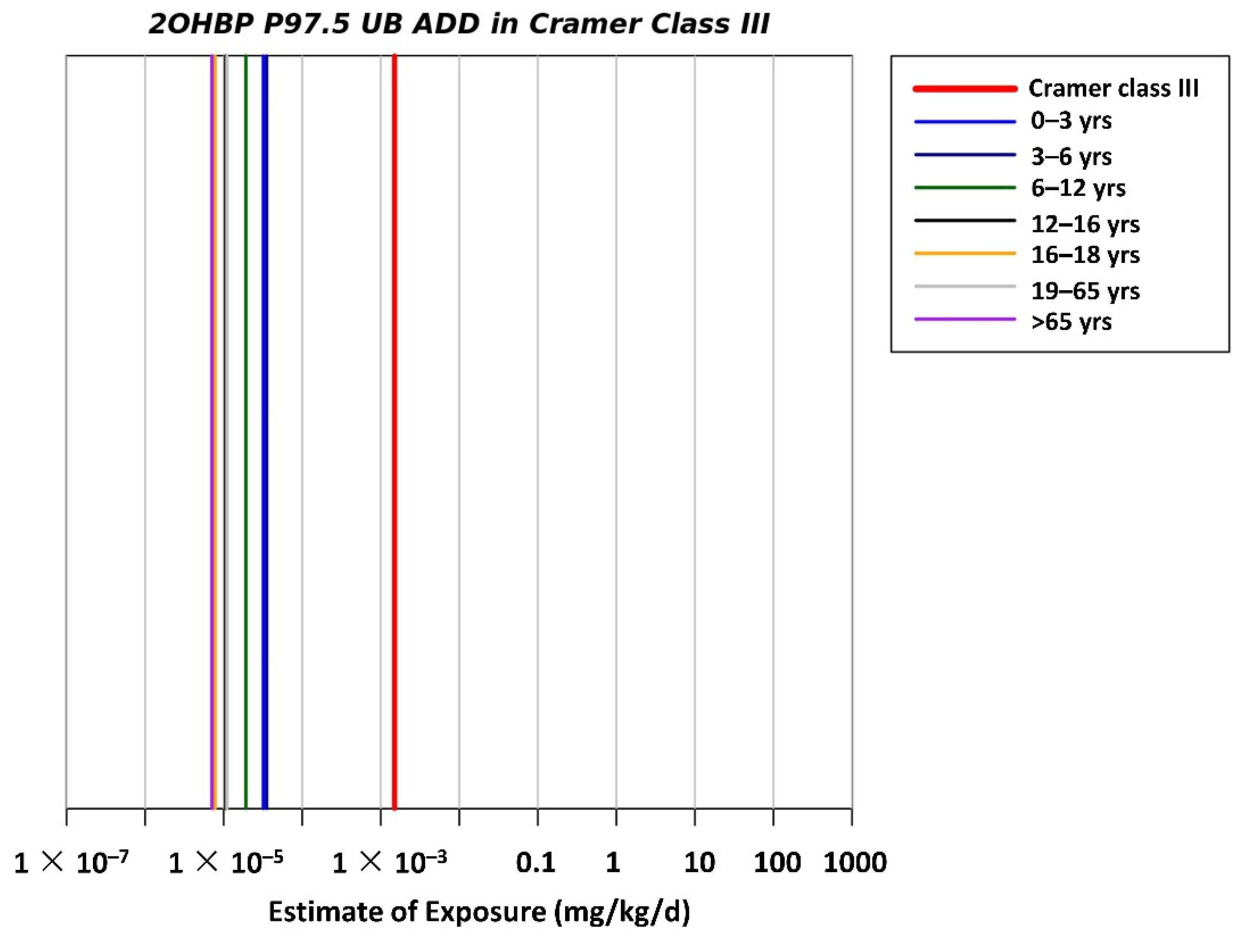
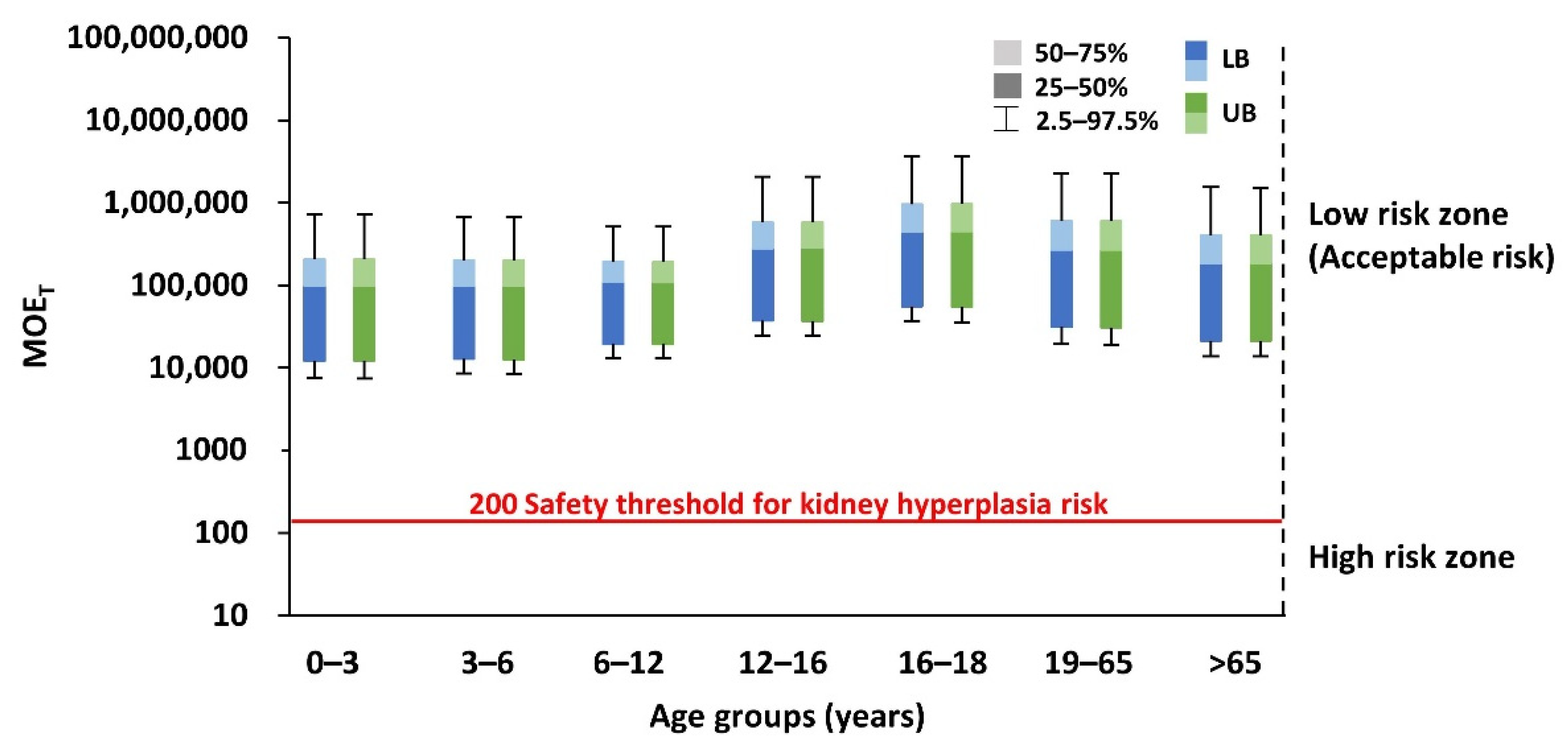
| Foodstuff | Analyte | Detected Rate (%) | Min (ng/g) | Max (ng/g) | Mean (ng/g) | SD (ng/g) | GM (ng/g) |
|---|---|---|---|---|---|---|---|
| Cereal I: whole grains–rice flour (n = 59) | BP | 100 | 17 | 108 | 38 | 20 | 34 |
| 4-MBP | 85 | <0.01 | 12 | 2.1 | 1.5 | 1.9 | |
| 4-OHBP | 5.1 | <0.51 | 33 | 17 | 15 | 12 | |
| PBZ | 1.7 | <0.07 | 0.94 | 0.94 | - | 0.94 | |
| Cereal II: whole grains–wheat and its products (n = 61) | BP | 100 | 14 | 68 | 21 | 8.4 | 20 |
| 4-MBP | 100 | 1.2 | 66 | 4.2 | 8.3 | 2.8 | |
| PBZ | 1.6 | <0.05 | 0.42 | 0.42 | - | 0.42 | |
| Cereal III: whole grains–processed grain products (n = 60) | BP | 100 | 22 | 1084 | 89 | 199 | 47 |
| 4-MBP | 100 | 0.90 | 12 | 2.6 | 1.8 | 2.3 | |
| 4-OHBP | 17 | <0.05 | 9.7 | 4.9 | 2.2 | 4.5 | |
| M2BB | 8.3 | <0.29 | 17.3 | 5.3 | 6.9 | 2.8 | |
| 100% fresh fruit and vegetable juice (n = 14) | BP | 100 | 8.0 | 29 | 12 | 5.4 | 12 |
| 4-MBP | 100 | 0.20 | 0.50 | 0.30 | 0.08 | 0.30 | |
| M2BB | 93 | 0.44 | 0.74 | 0.57 | 0.09 | 1.7 | |
| PBZ | 79 | 0.14 | 2.3 | 0.48 | 0.63 | 1.5 | |
| 100% reconstituted fruit and vegetable juice (n = 63) | BP | 100 | 7.3 | 51 | 16 | 9.2 | 14 |
| 4-MBP | 87 | 0.11 | 1.5 | 0.20 | 0.20 | 0.15 | |
| 4-OHBP | 1.6 | 0.82 | 0.82 | 0.82 | -- | 0.05 | |
| M2BB | 100 | 0.34 | 0.84 | 0.48 | 0.10 | 0.47 | |
| PBZ | 47.6 | 0.14 | 1.6 | 0.38 | 0.36 | 1.2 | |
| 10% or more fruit and vegetable juice (n = 59) | BP | 100 | 5.2 | 37 | 13 | 5.5 | 12 |
| 4-MBP | 95 | 0.12 | 8.5 | 0.70 | 1.4 | 0.34 | |
| M2BB | 100 | 0.37 | 0.81 | 0.54 | 0.11 | 0.52 | |
| PBZ | 54 | 0.14 | 0.95 | 0.29 | 0.19 | 1.2 | |
| Full-fat milk (n = 37) | BP | 100 | 4.5 | 16 | 8.1 | 2.3 | 7.8 |
| 4-MBP | 30 | 0.34 | 101 | 28 | 32 | 0.17 | |
| 4-OHBP | 5.4 | 8.2 | 12 | 9.9 | 2.3 | 0.14 | |
| M2BB | 35 | 0.22 | 0.46 | 0.29 | 0.09 | 0.14 | |
| PBZ | 57 | 0.41 | 2.6 | 1.6 | 0.70 | 0.22 | |
| Low-fat milk (n = 9) | BP | 100 | 4.2 | 15 | 8.2 | 3.6 | 7.6 |
| 4-MBP | 22 | 21 | 150 | 85 | 91 | 0.16 | |
| 4-OHBP | 11 | 9.1 | 9.1 | 9.1 | -- | 0.17 | |
| M2BB | 22 | 0.26 | 0.29 | 0.27 | 0.02 | 0.13 | |
| PBZ | 78 | 0.60 | 2.3 | 1.6 | 0.65 | 0.55 |
Publisher’s Note: MDPI stays neutral with regard to jurisdictional claims in published maps and institutional affiliations. |
© 2022 by the authors. Licensee MDPI, Basel, Switzerland. This article is an open access article distributed under the terms and conditions of the Creative Commons Attribution (CC BY) license (https://creativecommons.org/licenses/by/4.0/).
Share and Cite
Chen, M.-L.; Chen, C.-H.; Huang, Y.-F.; Chen, H.-C.; Chang, J.-W. Cumulative Dietary Risk Assessment of Benzophenone-Type Photoinitiators from Packaged Foodstuffs. Foods 2022, 11, 152. https://doi.org/10.3390/foods11020152
Chen M-L, Chen C-H, Huang Y-F, Chen H-C, Chang J-W. Cumulative Dietary Risk Assessment of Benzophenone-Type Photoinitiators from Packaged Foodstuffs. Foods. 2022; 11(2):152. https://doi.org/10.3390/foods11020152
Chicago/Turabian StyleChen, Mei-Lien, Chih-Hsien Chen, Yu-Fang Huang, Hsin-Chang Chen, and Jung-Wei Chang. 2022. "Cumulative Dietary Risk Assessment of Benzophenone-Type Photoinitiators from Packaged Foodstuffs" Foods 11, no. 2: 152. https://doi.org/10.3390/foods11020152
APA StyleChen, M.-L., Chen, C.-H., Huang, Y.-F., Chen, H.-C., & Chang, J.-W. (2022). Cumulative Dietary Risk Assessment of Benzophenone-Type Photoinitiators from Packaged Foodstuffs. Foods, 11(2), 152. https://doi.org/10.3390/foods11020152







